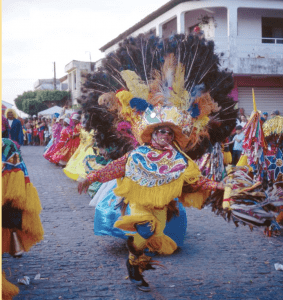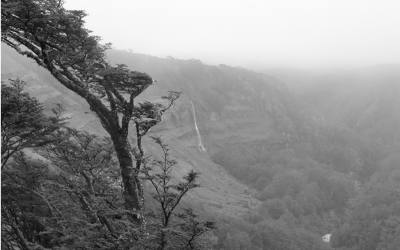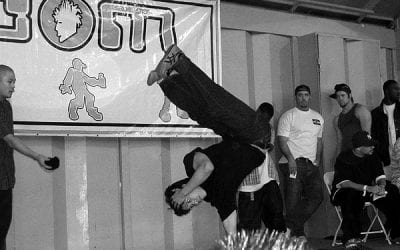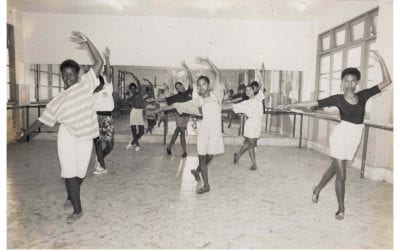Caboclo Ritual Dance
Bringing the Juke-Joint into the Church

Caboclo dancing in Brazil: the figure of the caboclo spirit is the Brazilian equivalent of the traveling bluesman of the pre-1960s u.s. rural south–—improvising vernacular poets. Photo by Jason Gardener
To give oneself to dance is to experience the moving body as sacred. For anyone who believes that the alienation of the body from the spirit is simply an inevitable symptom of modernity, I offer a personal challenge: are you certain you’ve danced already? But if you have and remain unconvinced, I leave you with this mini-narrative about a peculiar type of ritual popular in urban Brazil. May it inspire your thoughts for the next dance!
Having assumed the body of his black female host, a Brazilian caboclo [a beloved class of ancestral spirits] saunters forward, cigar butt clenched between his teeth and leather cowboy hat tilted at a forward angle obscuring his eyes, and kneels dutifully before the atabaque drums. Grunting loudly and pounding his chest a few times, the caboclo Boadeiro (cowboy spirit) captures everyone’s attention and the room is suddenly silent. From a kneeling position, he chants a series of prayers (rezas) in a high-pitched nasal vocal timbre and is answered by the rapid ringing of a small two-toned iron bell. Finally, the caboclo offers his brethren a melody, to which they respond by alternating an enthusiastic chorus phrase with his solos. Boadeiro rises to his feet and suddenly—slap, slap, crack! Three drummers have entered forcefully to breathe life into the song, falling into an energizing rhythm punctuated by the syncopated tones and slaps of the lowest sounding instrument. Shuffling his feet in time as he sings solo verses, and gradually incorporating more rapid and extended leg and torso gestures during the chorus sections, Boadeiro begins to narrate his identity and personalized mythology through song and dance.
In a variety of popular religions in Brazil, rituals for the caboclos are a modern development with increasing participation from all segments of society. The boisterously social caboclo will possess the body of a spirit medium for several hours at a time, enabling people to know him through direct social interaction. In the state of Bahia, the spirits manifest as traditional songsters who smoke cigars, drink beer and the fiery liquor cachaça, dance, sing and offer proverbial wisdom from dusk until dawn. These caboclos tend to exude such charisma, creativity, distinctive personality and knowledge of regional culture that they become the “life of the party” and exemplars of Afro-Bahian social performance. Here’s a succinct analogy: the figure of the caboclo spirit is the Brazilian equivalent of the traveling bluesman of the pre-1960s rural American South—improvising black vernacular poets who sing personalized narratives and fragments of wisdom gathered from adventurous journeys. Metaphorically, they are like the mythologized Robert Johnson or Son House returning from the dead to invoke the juke joint, with all its profane and sacred meaning, right inside the church.
Boadeiro’s movements sometimes amplify his lyrical descriptions, through mimicry of popularly imagined Brazilian “Indians,” cowboys, and backwoodsmen or danced representations of their personalities—variously youthful and energetic, irreverent, humorous, crafty, provocative, creative and bold. Boadeiro’s arms gesture about in wide-open embraces, unlike the more graceful and self-contained orixás whose closed eyes and mouth, and careful positioning of the limbs are a physical manifestation of the body’s spiritual closure. The caboclo’s mouth is always opening—ingesting and emitting things, whether to sing, joke, drink beer, inhale or exhale smoke. The eyes of the spirit are wide open, staring, and rarely blinking. He kicks his feet and legs outward in various directions, sometimes propelling his body high in the air, or shuffling himself rapidly across the floor. Through the caboclo’s body, spiritual power is not tactfully restrained, but dramatically exhibited—or perhaps generated—through athletic movements, astonishing endurance, speedy footwork, and spontaneous delivery of one song after another.
Though Bahian caboclo ritual dances define a unique style of their own, I can trace relationships in the movements to other regional traditions including capoeira, samba-de-roda, coco and frevo. The caboclo’s virtuosic solo dancing, and intensely interactive exchanges with the lead drummer also bring to mind the street rumbas of Cuba. Yet these comparisons, obvious to an experienced local practitioner, are easily overlooked by foreign scholars. Perhaps one reason is that we assume “secular” activities—rumba, samba-de-roda and the other popular dances—do not involve religious content, or spirit possession. Looking for the sacred in the cities of Havana, Recife and Salvador, I’ve seen the African deity Chango at a Cuban rumba, coco house parties thrown for the spirits of Candomblé and even a mischievous caboclo seizing an unsuspecting medium in broad daylight at a Bahian samba-de-roda!
But before our readers mistake the trickster at the crossroads for an exotic demon, let me issue a reminder that the dancing, joking, and singing caboclo is a familiar, socially accessible, and virtuous character to Bahians. Hold on, blues people, I’m heading homeward for the coda: we can recognize that the Afro-American “ring shout” has been formally separated into the “ring” (popular dance) and the “shout” (religious dance), but I wouldn’t say that the sacred is absent from either. In the African Diaspora, modernity, dance and spirituality seem to get along quite nicely. To revisit the blues analogy, if the caboclo can “bring the juke joint into the church,” certainly it is possible to “get some religion at the Saturday night dance.”
Daniel Piper is a Ph.D. candidate in Ethnomusicology at Brown University. His current research in northeast Brazil focuses on the intersections of race and religious expression in regional dance music performance. Dan’s favorite dance is Cuba’s rueda-de-casino.
Related Articles
Editor’s Letter: Dance!
We were little black cats with white whiskers and long tails. One musical number from my one and only dance performance—in the fifth grade—has always stuck in my head. It was called “Hernando’s Hideaway,” a rhythm I was told was a tango from a faraway place called Argentina.
Brazilian Breakdancing
When you think about breakdancing, images of kids popping, locking, and wind-milling, hand- standing, shoulder-rolling, and hand-jumping, might come to mind. And those kids might be city kids dancing in vacant lots and playgrounds. Now, New England kids of all classes and cultures are getting a chance to practice break-dancing in their school gyms and then go learn about it in a teaching unit designed by Veronica …
Dance Revolution: Creating Global Citizens in the Favelas of Rio
Yolanda Demétrio stares out the window of our public bus in Rio de Janeiro, on our way to visit her dance colleagues at Rio’s avant-garde cultural center, Fundição Progresso. Yolanda is a 37-year-old dance teacher, homeowner, social entrepreneur and former favela (Brazilian urban shantytown) resident. She is the founder and director of Espaço Aberto (Open Space), an organization through which Yolanda has nearly …




